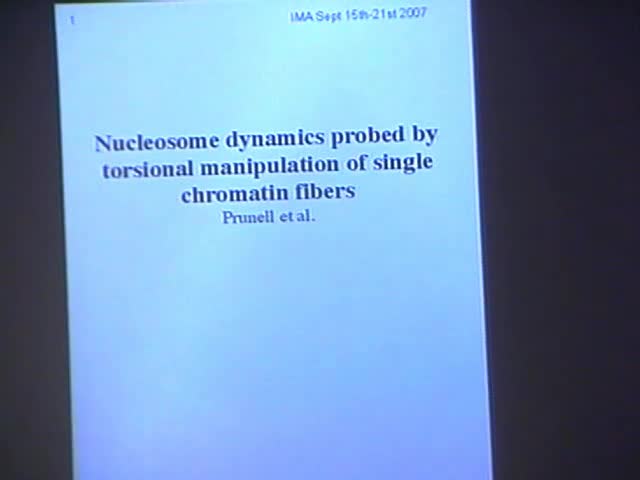Nucleosome Dynamics Probed by Torsional Manipulation of Single Chromatin Fibers
Presenter
September 18, 2007
Keywords:
- DNA sequences
MSC:
- 92D20
Abstract
Single chromatin fibers were reconstituted in vitro
by salt dialysis from purified histone octamers and 2×18 tandem
repeats of the 5S DNA positioning sequence. The fibers were
flanked by naked ∼600 bp DNA spacers and ∼500 bp DNA stickers
modified with digoxigenin and biotin destined to be linked
respectively to the coated bottom of the flow cell and to the
paramagnetic bead. This construction is then placed under the
rotating magnet of a magnetic tweezers set-up to exert a torque
and a pulling force on the fiber.
The fiber stretching (force-vs.-extension) and torsional
(extension-vs.-rotation) behaviors were then recorded. Whereas
the stretching behavior is similar to that previously observed
by other authors using e. g. optical tweezers, the torsional
behavior shows a bell-shaped curve with a breath much larger
than obtained with naked DNA of the same length.
These curves were fitted with the worm-like rope model widely
used for DNA, which represents the molecule (here the chromatin
fiber) as an isotropic elastic rod of defined bending,
stretching and twisting moduli. Good fittings were obtained
with a fiber bending persistence length of 28 nm and a
stretching modulus of 8 pN, in agreement with previous studies.
In contrast, the twisting persistence length, obtained here for
the fist time, was exceptionally low, ∼5 nm against ∼80 nm for
DNA.
Such a fiber high torsional resilience was inconsistent with
the existence of nucleosomes locked in their canonical
negatively-crossed conformation. In contrast, it could be
described by a molecular model of the fiber architecture in
which nucleosomes are in a thermodynamic equilibrium between
the three conformational states initially identified for single
nucleosomes on DNA minicircles (reviewed in ref. 1), depending
on the crossing statuses of entry-exit DNAs (negative, null or
positive). Beyond applied torsions at which all nucleosomes are
forced to cross either negatively or positively, the fiber
length decreases rapidly and linearly. By analogy to the
torsional behavior of DNA (ref. 2), this was attributed to the
formation of plectonemes, in which nucleosomes are extruded to
the outside (ref. 3).
When fibers were submitted to large positive torsions beyond
their maximal compaction, the backward curves obtained upon
reversing the torsion depart from the onward curves. A positive
shift is observed at positive torsions which progressively
disappears at negative torsions. This reversible hysteresis
corresponds to the transition of the nucleosomes to a transient
altered state which traps one positive turn. Comparison with
the response of fibers of tetrasomes obtained through depletion
of H2A-H2B dimers using NAP-1, heparin or salt led us to
conclude that the transition involves three main steps : 1) a
breaking of the docking of the dimers on the (H3-H4)2 tetramer;
2) a switching of the tetramer from its left-handed to the
right-handed chiral conformation previously described (reviewed
in ref. 4); and 3) a undetermined rearrangement of the dimers
insuring that the overall compaction of the resulting
“reversomes” (for reverse nucleosomes) is similar to that of
the starting nucleosomes (ref. 5)
This dynamics of the nucleosomes at the level of the entry-exit
DNAs, which leads to a large reorganization of the
three-dimensional fiber architecture, may affect DNA binding of
regulating proteins in vivo, as all tracking processes, e. g.
replication and transcription, involve the generation of
torsional stress. The nucleosome-reversome transition is likely
to serve to relieve the almost insurmountable block against
transcription by the main RNA polymerase otherwise exerted by
H2A-H2B dimers in the absence of intervening factors.
References
1) Prunell A. & Sivolob A. (2004) . "Paradox lost : Nucleosome
structure and dynamics by the DNA minicircle approach" In
Chromatin structure and dynamics : state-of-the-art.
(Zlatanova, J. & Leuba, S. H., eds), Elsevier Science,
Amsterdam. New Comprehensive Biochemistry, 39, 45-73.
2) Strick, T. R., Allemand, J. F., Bensimon, D., Bensimon, A.
and Croquette, V. (1996). The elasticity of a single
supercoiled DNA molecule. Science 271, 1835-1837.
3) Bancaud A., Conde e Silva N., Barbi M., Wagner G., Allemand
J.-F., Mozziconacci J., Lavelle C., Croquette V., Victor J.-M.,
Prunell A. & Viovy J.-L. (2006). Structural plasticity of
single chromatin fibers revealed by torsional manipulation.
Nat. Struct. Mol. Biol. 13, 444-450.
4) Sivolob A. & Prunell A. (2004). Nucleosome conformational
flexibility and implications for chromatin dynamics. Phil.
Trans. Roy. Soc. A. 362, 1519 - 1547.
5) Bancaud A., Wagner G., Conde e Silva N., Lavelle C., Wong
H., Mozziconacci J., Barbi M., Sivolob A., Le Cam E., Mouawad
L., Viovy J.-L., Victor J.-M. & Prunell A. (2007). Nucleosome
chiral transition under positive torsional stress in single
chromatin fibers. Mol. Cell 27, 135-147.
